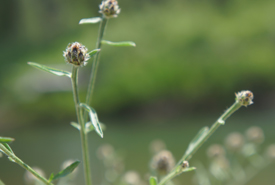
Spotted knapweed (Photo by NCC)
Spotted knapweed
Spotted knapweed, a member of the sunflower family, is an aggressive invader that is especially problematic in native grasslands in western Canada and has recently spread to Manitoba. There are five invasive knapweed species in Canada, unintentionally introduced from Europe in the late 1800s. It is predicted that the species was spread via alfalfa and clover seeds.
How is it identified?
Spotted knapweed has a slender stem and can reach heights of up to approximately 1.5 metres. Similar to the other four invasive knapweed species, spotted knapweed has purple (or sometimes white) flowers and grows from a deep taproot. Unlike the other knapweed species, the base of the spotted knapweed’s flowers has black tips, making it appear spotted. Its leaves are slightly hairy and decrease in size towards the top of the stem.
How does it grow?
Spotted knapweed only reproduces by seed. Because each plant can produce more than 140,000 seeds per year, it is very challenging to control established infestations. The species flowers in late June and early July, and produces mature seeds in July and August. The seeds are spread passively by animals and wind, as well as by contaminated hay.
Where does it grow?
Although spotted knapweed is found in most Canadian provinces and one territory (BC, Alberta, Saskatchewan, Manitoba, Ontario, Quebec, New Brunswick, Nova Scotia and Yukon), it grows mainly in southwestern Canada. Spotted knapweed prefers to grow on well-drained, light to coarse soil and does not tolerate dense shade or constant moisture. It is commonly found in grasslands, open forests and along roadsides.
What does it threaten?
Spotted knapweed has many negative impacts. For example, it releases a chemical that hinders native plants’ root growth and displaces vegetation. Also, infestations can decrease food quantities for wildlife and livestock. As well, large infestations can increase erosion and runoff. The plant also degrades rangelands, especially in parts of southern BC. Finally, dead plant material can increase fire risk.
What is being done to control this species?
Methods to control spotted knapweed populations include grazing, cutting and pulling, herbicides and bio-controls. Grazing is best done when the plant is in its rosette stage and when done in conjunction with herbicide use. Cutting or pulling before flowering can be good for small infestations to stop seed production, but requires many years to completely eliminate. Three moth, four fly and four weevil species that were imported to North America as bio-controls have led to major decreases in plant size and seed production in some regions. NCC hosts Conservation Volunteers events to control spotted knapweed populations.
How can you help?
Everyone can help win the battle against invasive species. Here are several ways to do your part:
- Dispose of yard waste properly. Dumping yard waste in natural areas can introduce invasive species, which can thrive and spread. Even leaf piles can be problematic, as dumped piles can smother native vegetation. Contact your municipality to find out how to dispose of yard waste properly.
- Plant native species in your garden. There are lots of beautiful native species that attract native butterflies and birds, making your garden twice as beautiful. Native species are also adapted to our climate and often require less rigorous care than exotic species.
- Clean your shoes or bicycle tires when moving between designated trails in different areas. Invasive plants are often spread accidentally from seeds stuck in treads.
- Learn about the most invasive plants in your local area. Do an audit of your yard to ensure none are growing on your property.
- Report new occurrences of invasive plants to provincial invasive species councils or through apps, such as iNaturalist. By helping track the spread of invasive species, scientists and land managers can identify the best places and methods to control them.



